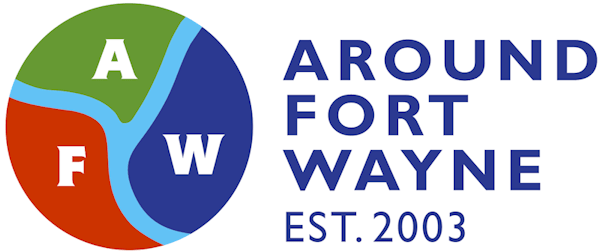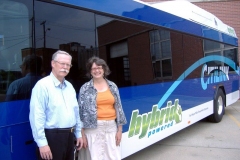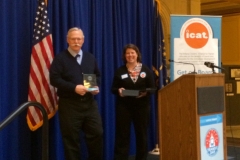PLEASE NOTE: Just to clarify for everyone, even though this issue is outside my usual purview, I feel compelled to follow it because I rode the bus for almost 15 years when moving to Fort Wayne, up until I made the decision to begin driving again almost three years ago. I deeply care about the system and think it a vital part of our community.
I truly think Citilink hasn’t mismanaged funds. I want to make that very clear here. That is not the reason I am covering this. Do I think Citilink should have raised fares a year or two ago? Yes. Do I think they have been very frugal and responsible with spending? Yes. But now that they are in this dilema, it’s important not to make a misstep that could bring the house of cards down.Â
(The above two paragraphs added June 1, 2008.)
Â
According to articles in the Journal Gazette and News-Sentinel, more details about rate hikes are becoming apparent.
From the Journal Gazette:
The proposal would increase regular daily fares from $1 to $1.25 and its reduced fares from 50 cents to 60 cents. It would also eliminate its transfer program, requiring customers who switch buses to pay two fares.
To counter those increases, Citilink would begin offering a $3 day pass to provide unlimited rides for a day. The $45 monthly pass would not be increased in an effort to encourage riders to use it.
First of all, isn’t eliminating free transfers doubling fares for some passengers? If you’re not sure what a transfer is, here’s an example. Currently, if I were to board a bus at IPFW with a destination somewhere in Waynedale, I’d pay my $1 for the entire trip. But under the proposed fare structure, I’d pay $1.25 at IPFW when boarding, and then when I arrived downtown at the transfer station, I’d get off the IPFW bus walk to the next bus and pay another $1.25. Theoretically, that would mean paying up to $5 for a round trip. The Citilink’s plan of offering a $3 day-pass is intriguing, however, is it high enough for a day pass?Â
Also, only raising reduced fares from 50 cents to 60 cents isn’t in proportion to the quarter raise in regular fares, close but not quite. Not raising the fee for a monthly pass is also a mistake. Yes, it will encourage people to purchase the monthly pass, but is this just shooting themselves in the foot?
The article also states the Citilink board will go before the Fort Wayne City Council on June 10, 2008 to request whatever funds would be available. Good luck with that.
From the News-Sentinel:
The service cuts would eliminate one route, reduce weekday service on three others, Saturday service on another and restrict Access service — curbside service for riders with disabilities — to three-quarters of a mile from existing routes. Citilink also would lay off six full-time drivers along with its entire part-time Access staff.
Citilink’s budget shortfall stems from rising fuel costs — projected at about $386,000 more than budgeted — and the loss of an expected $634,150 in revenues from the governor’s plan to reduce the state’s reliance on property taxes.
Service cuts and layoffs would be regrettable. So I guess more questions remain unanswered. How were the price increases arrived at? Why has Citilink waited so long to take action to raise their fares? I can remember numerous times over the past few years when they were having budget problems or concerns, and yet they steadfastly refused to raise fares. What is the long-term plan? Sure, this might get them through next year, but I haven’t heard anything about next year’s hit the budget might take from reduced property tax revenues.Â
I never received a response to my earlier email (see Citilink Woes). I will be making more of an effort this week to contact someone for a possible interview about the situation.








Something’s missing here. I do applaud CitiLink for the three community meetings seeking input. I think they were stiffed by the State’s state and local finance empire making the budget shorfall from HB 1001 significantly worse.
But why is this search for answers only looking outward to the bus users? Let’s just pretend that this happened in the private sector. Yes, they would look at raising user fees but they would also look within.
CitiLink seems to have been spartan and frugal over the years, and so it’s hard to find fat to cut.
However, a private employer would look at Compensation. There are 122 employees and none of them need to be laid off or routes eliminated. This type of review would try to maintain or improve services, and do so by making sacrifices themselves and asking bus patrons to do as well.
Here’s an example. The JG and NS stories described the labor rates and the fringe benefits as very generous. How about looking at those company-paid fringes? Both the health insurance and pension programs could increase or require the employee sharing and contributing. The private sector does this. Without the numbers, I can’t estimate savings, but they would be big depending on the extent of the employee pay in.
Another example would be this: eliminate the next vacancy. With an average salary of 40K and a 50% fringe ratio, that would save 6oK anuually.
Or change the paid vacation to cap it at 2.5 weeks. Some employees have 3 and 4 weeks vacation. In good times, that’s fine. But it’s time to make sacrifices.
Limiting paid vacation would save big bucks, allow services to be maintained, and allow cutting one or two vacancies.
Without access to the budget numbers, it’s not possible to estimate the savings from these ideas, but they are worth looking into.
After all, the public is not as tolerant today to have the disparity in compensation between public and private employees, especially with more and more private employers eliminating health insurance and never offering company paid pension in the first place.
This type of internal look at budget savings needs to be done. Compensation cannot remain a sacred cash cow to the taxpayer and the bus patrons. It would also help avoid cutting routes, rasing fares out of reach, and yes avoid cutting filled positions.
Hi Dan!
Many thanks for the thoughtful, well written comments. That said, I think you’ve hit the nail on the head.
I remember, back in the day when I was pretty friendly with several of the drivers, thinking during chats with them that they had one of the strongest unions in the world. Some of the benefits and practices I was told about were astounding! I truly think that is the problem here. Their union is strong and they are locked in contractually with certain benefits and wage structures and cannot do much to change it.
If you look at their 2006 Annual Report, Operator Salaries/Wages are $2.6 M while Other Salaries/Wages are listed at $1,052,301. If you add the Operator and Other Salaries and divide by the # of employees listed on the report, it comes out to an average of $30,206. But the number of employees also includes 17 part-Time employees, which would suggest to me that the average for a full-timer could be even higher.
There is also a listing of “Fringe” at $2.6 M. I am wondering if this means Fringe Benefits? If so, that says something right there. Now what all the Fringe Benefits would include, I’m not sure. I imagine it includes things like vacation pay, health insurance and even pension payments.
The only other comment I’ll make at this point about the 2006 Annual Report is the “Materials and Supplies” expense listed at $1.5 M. That seems to be a lot of materials and supplies for a bus company.
More thoughts on the Citilink deal. I will submit something at their public meetings. I wish I knew more about the Union contract and the budget line item details, but so be it.
I am as pro-Union as the next person, but there are times when contracts need to be reoponed especially when the funding that the contracts were predicated on falls through. So I do think it is fair game to suggest Compensation changes.
Also, I am a patron too. Tomorrow I will take the bus from IPFW to downtown to transfer to get all the way home. Many people transfer at the downtown location. To do away with transfers is going to hurt many. In my example, it would cost $4 to get from IPFW to home. Now I am better off driving.
I see many high schoolers involved in extracirruclulars like band and football coming from all parts of the city on non-school days to Snyder, and they are all needing transfers to do so. For them, it would mean 4 tickets in one day to get to and from band practice in August or football practice in August.
I know people who work in nursing homes on the north side and take the bus from the south side needing a transfer. It would cost them $4 to get to work and $4 to get home, and starting pay nurse aides make that per hour. So for them, they work on hour out of eight hours just for their bus fares.
The transfer proposal makes no sense.
Alternatively, Citilink could offer 10-paks or a ticket good for 10 rides for $12. That would help workers working 5 days a week, and students who take the bus to school and back, and others.
There needs to be another option besides the monthly pass which is overpriced at 45.
A 10 pak or a weekly pass makes more sense, and then charge 25 cents for a transfer.
Thanks for posting this issue. It affects the people-it is very real and it matters to one’s quality of life. If one can’t get there because of price, then let’s keep the price within reach and people can get where they need to go.
I need to clarify that the examples used above assume a doubling of the fare from one to two dollars. Then it makes sense. Even if the fares are not doubled, the points are still valid with lesser degrees of “consumer pain.”